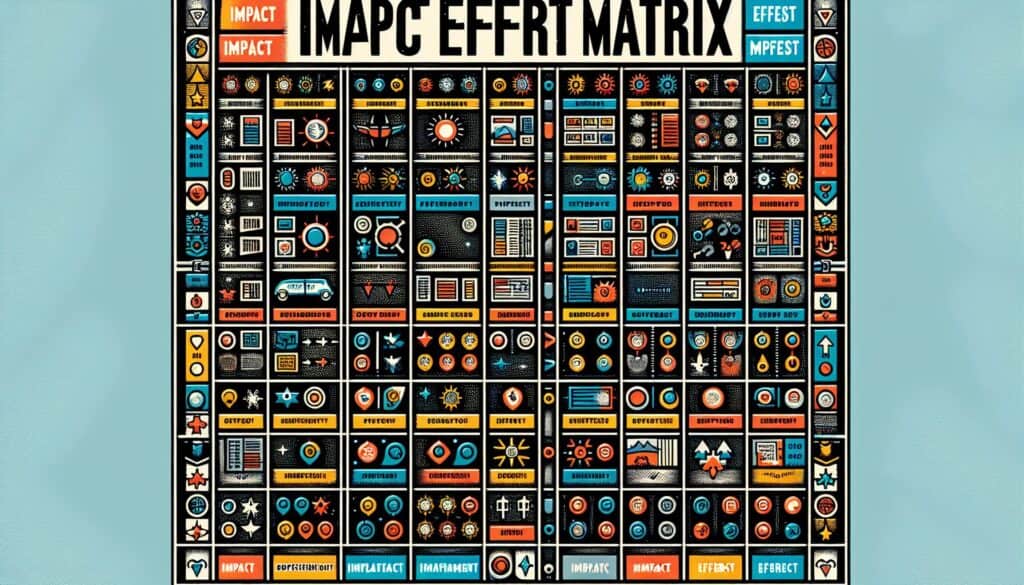根据任务或计划的潜在影响以及实施这些任务或计划所需的努力,确定其优先次序。
- 方法: 客户与营销, 经济学, 产品设计
影响努力矩阵

影响努力矩阵
- 敏捷方法论, 持续改进, 设计思维, 精益制造, 项目管理, 质量管理, Scrum, 可持续发展实践, 价值流映射
目标
如何使用
- 一个 2x2 的网格,其中一个轴代表影响(如高/低),另一个轴代表努力(如高/低)。将项目绘制在矩阵上,以确定速赢项目(高影响、低努力)、重大项目(高影响、高努力)、填充项目(低影响、低努力)和不费力的任务(低影响、高努力)。
优点
- 简单、直观;便于快速决策和确定优先事项;帮助团队专注于投资回报率最高的活动;鼓励就优先事项进行讨论并达成共识。
缺点
- 在评估影响和工作量时存在主观性;可能会过度简化复杂的决策;在没有额外背景的情况下,不会考虑任务之间的依赖关系或战略一致性。
类别
- 构思, 解决问题, 项目管理
最适合:
- 快速排列想法、项目或任务清单的优先顺序,以确定首先要关注的事项。
The Impact Effort Matrix is commonly employed in various industries including software development, product management, and engineering, particularly during the ideation and planning phases of projects. This methodology aids teams in evaluating potential initiatives by visualizing which tasks could lead to significant benefits with minimal resource investment, allowing for efficient allocation of efforts. In software development, for example, a team might identify user interface enhancements that could improve customer satisfaction significantly while requiring little coding effort, thus categorizing them as quick wins. Conversely, a manufacturing firm might plot a new product line launch that promises high returns but demands extensive R&D and market validation, positioning it within the major projects quadrant. Stakeholders from cross-functional teams, including marketing, design, and engineering, typically contribute to this exercise to leverage diverse insights and foster collective decision-making. The visual nature of the matrix facilitates discussions that can align team members on priorities, ultimately driving a consensus on which initiatives should receive immediate attention to maximize efficiency and effectiveness in project execution. This approach not only accelerates decision-making but also improves transparency in the prioritization process, ensuring that team efforts are concentrated where they can yield the most substantial impact.
该方法的关键步骤
- Define criteria for impact and effort based on project goals.
- List ideas, projects, or tasks that need prioritization.
- Assess and assign impact and effort scores to each item.
- Plot the items on the 2x2 grid based on their scores.
- Identify and categorize items in the quadrants: quick wins, major projects, fill-ins, and thankless tasks.
- Discuss and prioritize actions based on the visual representation of the grid.
- Determine next steps for implementing the prioritized items.
专业提示
- Incorporate stakeholder feedback in the matrix creation process to align project priorities with organizational goals.
- Regularly update the matrix as new data or insights emerge, ensuring that your prioritization reflects current market conditions and customer needs.
- Utilize color-coding or tagging on the matrix for different team members or departments to visually represent responsibility and improve collaborative discussions.
历史背景
1960
1980
1983
1990
1995
2000
2010
1950
1980
1980
1986
1994
1995
2000
(如果日期不详或不相关,例如 "流体力学",则对其显著出现的时间作了四舍五入的估计)。














相关文章
肌肉骨骼不适调查表
多变量测试(MVT)
多元回归分析
动作捕捉系统
MoSCoW 方法
情绪中值测试